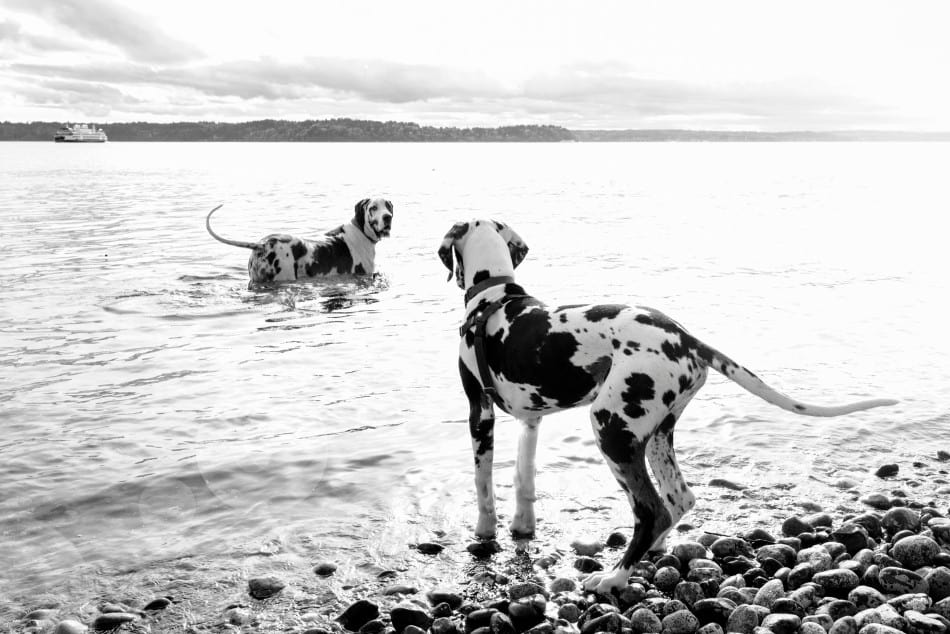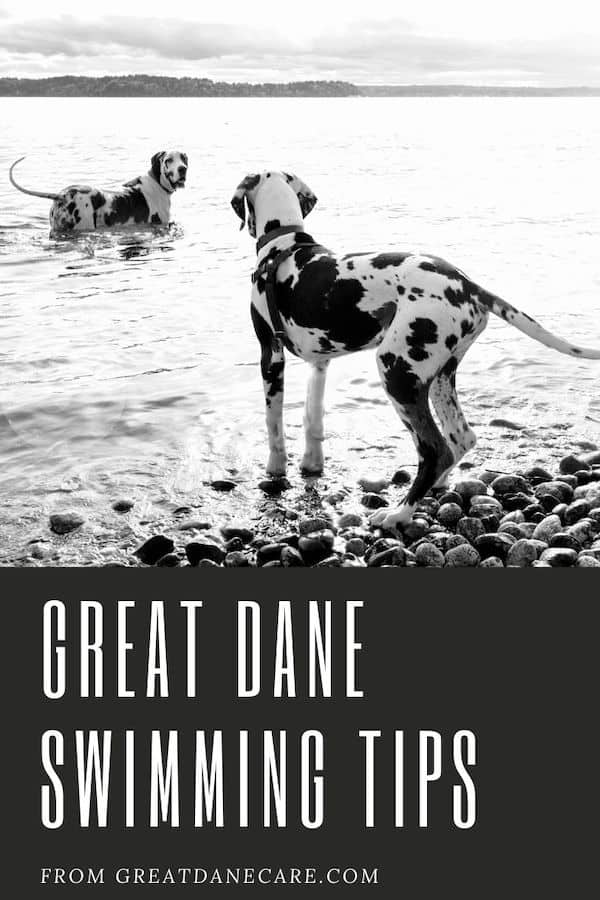
Great Dane’s are one of the most recognizable breeds, and if you own one, you’ll know they’re a low key dog. Despite their size, they do have physical limitations, and oftentimes there are misconceptions as to if they can swim or not.
Most Great Danes are not the best natural swimmers, but with a little practice, they can quickly become competent. Getting them comfortable being in and around the water is one of the first places to start.
To say Great Danes are good swimmers would be a stretch, but that doesn’t mean that they are unable to swim. There are some dog breeds that cannot swim at all, but Great Danes are at least teachable.
Knowing your dog’s temperament, as well as their general physiology, will help you to determine how well they will do while in the water.
Are Great Danes Good Swimmers?
No matter the dog breed that you have, water safety is important to understand and be aware of whether you’re by a lake or a pool. Not all dogs are capable of swimming, and if you have a Great Dane, they might not know how to swim.
Now, virtually all Great Danes are strong enough to tread water if necessary, but there are certain physical aspects that make them not so efficient swimmers overall.
Although they are strong dogs, you will need to watch them while they swim for signs of exhaustion or drowning. As with human children, you should watch them around swimming areas in case of distress.
How Great Danes Swim
Despite the fact that they are not natural-born swimmers, they still love to play and wade in shallow water, especially on a hot day. This makes for a fantastic way to cool off!
If they get into deeper waters, their large stature and upper body will generally allow for them to “doggy paddle” for a short distance.
When your Great Dane is swimming, their front legs will guide most of the motion, and their back legs will be used to steer and keep up the momentum.
Their front paws will move side to side, at the surface of the water, or coming in and out of the water as they paddle. This helps them to make larger motions as well as hold their heads above the water to breathe.
Their back legs will also be moving but in a kicking motion. While their hind legs aren’t able to propel them as well as their front, the movement helps them to keep the paddle motion, stay afloat, and keep them moving forward without losing momentum.
How Dogs Show Distress When Swimming
There are some breeds of dogs that are unable to swim at all due to their breed’s body build while there are others that are natural-born swimmers.
Since Great Danes fall somewhere in between, it is especially important to be vigilant when you do bring them into areas with deep water or are introducing them to the act of swimming.
Even if it looks like your dog has gotten the hang of their doggy paddle, that doesn’t mean that they won’t get tired or become anxious and panic.
The most common signs that your dog may be struggling to continue to swim is if they slow down and begin to paddle much slower than before.
As with humans, if your dog is struggling to keep their head above water or appears to be gasping for air, they will likely need your help to get out of the water.
Although Great Danes are quite strong, if they are older and just being introduced to water, they may become fearful and be unable to continue after just a short time.
Understand Your Dog’s Temperament
Great Dane’s are often known as the gentle giants of the dog world, but that doesn’t mean that they are immune to aggression, stress, or fear.
When put in certain situations, especially those they’re unfamiliar with, even the sweetest Great Dane can become aggressive with their owner or trainer in order to try and escape the situation.
This aggressive and/or fearful behavior usually becomes more prominent in older dogs that have not been properly socialized or trained. When introduced to new people or environments, it will become overstimulating and overwhelming.
Knowing your dog’s usual behavior and observing their body language and other cues when you begin to introduce them to swimming and bodies of water will be important.
Your dog may do well with a pond or lake but then become fearful of a pool or the ocean. Be observant and listen to what your dog is telling you. When it comes to water, it is best not to force them beyond their limits.
Train Your Great Dane to Swim
Great Danes have the ability to learn how to swim, but it is best to begin training them at a young age. This will allow you to move past certain emotional hurdles, and your dog will have less predetermined reactions.
If you’re comfortable with it, you can train your Great Dane yourself, but don’t rule out the idea of hiring a professional trainer or at least consulting one.
If you want your dog to be a successful swimmer, you want to ensure that you will not be doing anything that could impair their abilities. So, do your research before you get started!
Introducing Your Great Dane to the Water
As with any new stimuli, your dog’s reaction will depend highly on their age, training, and temperament.
If you have a Great Dane puppy, it will be much easier to begin to introduce them to the activity of swimming versus an older Great Dane that has established behaviors.
Now, it isn’t impossible to train a mature Great Dane to swim, but you will have to take more time when getting them used to the water in order for them to become comfortable with the situation.
One of the best things to do with a dog of any age when you are getting them used to the water is to bring them to a beach or pool often and allow them to play and wade in shallow parts.
Most dogs love running through puddles of water and splashing about on hot days. These interactions will become positive reinforcement to the scenario and will not cause them to associate fear or dislike for the water.
Often times, our dogs need to see that it is safe for them to be in the water, and one of the best ways is to get in the water first.
Demonstrating to them that it is okay is the first step in making them comfortable, and plus, then you can call them into the water once you’ve waded out.
Continued Exposure to the Water
As your Great Dane gets used to being in and around shallow water, you will want to introduce them to the act of swimming. This will likely be the scariest part for them as they are not used to the feeling.
Taking things slow and making sure they are comfortable are the most important aspects here.
As with human children, when they learn to swim, an adult will hold them to get comfortable and then slowly allow them to take over. This is the best way to build up your dog’s confidence, as well.
Having you next to them will make them feel safe, and as they get the motions of doggie paddling down, you can begin to let go.
If this isn’t working for your dog, you may need to try having them wear a life vest or use an inflatable for some time. Not all dogs learn at the same pace, and some will need more practice than others. Be patient, and with time, your Great Dane will be swimming on their own.


Took our 20 month old Dane for his 2nd swim session in a professional aqua therapy pool yesterday. (Been restricted with the lockdown and his last swim was 5 months ago.)
As you mention, they are certainly not natural water babies, but with a flotation jacket and a couple of the pool instructors either side to reassure him, he eventually calmed down and the would release him at one end of the pool and he would swim by himself to the ramp to get out. Bit like a swan. Fairly graceful up top, but legs flailing around under the surface.
It’s quite tiring for them and we took him out after 20 minutes and a reasonable amount of distance covered for a beginner. It helped having our chocolate Lab in the pool with him as he’s a natural, so the big boy took some comfort from this.